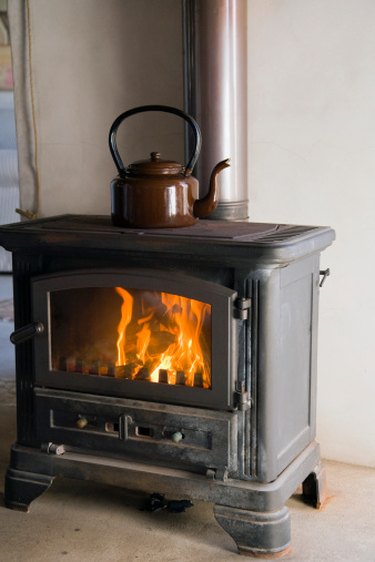
Unlike some newer efficient gas stoves, which can be vented with a direct vent that goes out the wall, all wood stoves need to be vented through a chimney. Burning wood, even in airtight and very efficient stoves, creates enough smoke that the stove needs to be vented over the top of a house.
Stone or Brick Chimney
Video of the Day
A chimney that is built of stone or brick is the most durable and the most aesthetically pleasing option for a wood stove. This type of chimney is very heavy and needs to be seated on a solid base. If you are building a stone or brick chimney on a floor with a basement under it, you will need to build a base underneath where the chimney is going to prevent it from crashing through your floor. The chimney needs to extend at least 3 feet above the ridge line of your roof to create sufficient draw and avoid backdrafts into your stove.
Video of the Day
Insulated Steel Chimney
Insulated steel pipe is an inexpensive alternative to stone or brick. While the sections of pipe are quite expensive, the labor required to install the chimney is a fraction of that for stone or brick, so the cost of hiring someone to install it will be lower. An insulated steel chimney can be attached to the outside wall of a house and extended above the roof line, or it can be run up through the center of the house and through the roof. The latter option allows more of your heat to radiate into your living area rather than outside.
Stove Pipes
The wood stove is connected to the chimney with a stove pipe, usually made of single-walled black metal. Depending on the style of your stove, the stove pipe will come out the top or the back of your stove. To create the best draft, the stove pipe should go straight up for 2 feet, then make a right turn and enter the chimney through a hole in the side of the chimney called a thimble.
Chimney Liner
The purpose of a chimney liner is to isolate the heat of the smoke and gases from the exterior surface of the chimney, which improves the draft in the chimney and protects residents of the house from potential burns. Chimney liners are made of ceramic tubes that are stacked inside of each other on the inside of the chimney. If you have a chimney with a broken or compromised liner, you can replace it with a steel liner. Steel liners are flexible steel tubes that can be retrofitted into existing chimneys.